Ada Lovelace Day | Fran Allen, IBM Fellow and A.M. Turing Award Winner
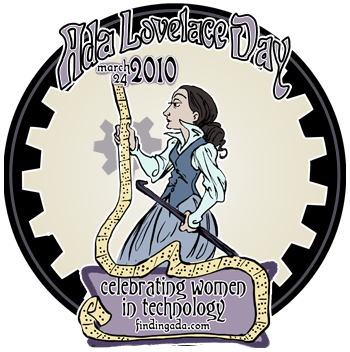 For the second annual Ada Lovelace Day, March 24, 2010 - celebrating women in science and technology - I've chosen to write about Frances E. Allen, IBM Fellow, Turing Award winner and pioneer in the theory and practice of optimizing compilers. I've never had the pleasure of meeting her in person, but I'll take the liberty of calling her Fran, as Dick Merwin and everyone I know called her in their Fran stories.
For the second annual Ada Lovelace Day, March 24, 2010 - celebrating women in science and technology - I've chosen to write about Frances E. Allen, IBM Fellow, Turing Award winner and pioneer in the theory and practice of optimizing compilers. I've never had the pleasure of meeting her in person, but I'll take the liberty of calling her Fran, as Dick Merwin and everyone I know called her in their Fran stories.
Garry Kasparov on Computer Chess and Enterprise 2.0
 Professor Andrew McAfee posted a very good business analysis of points made by Garry Kasparov in his Feb 11, 2010 New York Review of Books article on Diego Rasskin-Gutman's book Chess Metaphors: Artificial Intelligence and the Human Mind. Kasparov's summarized of his own thoughts as a Chess Grandmaster and world chess champion playing against - and losing to - IBM's Deep Blue chess computer. But the interesting part comes when Kasparov talks about a recent match open to grandmasters who were allowed to use computer chess programs of their choice to augment their own chess skills: "The surprise came at the conclusion of the event. The winner was revealed to be not a grandmaster with a state-of-the-art PC but a pair of amateur American chess players using three computers at the same time." McAfee quotes Kasparov and continues:
Professor Andrew McAfee posted a very good business analysis of points made by Garry Kasparov in his Feb 11, 2010 New York Review of Books article on Diego Rasskin-Gutman's book Chess Metaphors: Artificial Intelligence and the Human Mind. Kasparov's summarized of his own thoughts as a Chess Grandmaster and world chess champion playing against - and losing to - IBM's Deep Blue chess computer. But the interesting part comes when Kasparov talks about a recent match open to grandmasters who were allowed to use computer chess programs of their choice to augment their own chess skills: "The surprise came at the conclusion of the event. The winner was revealed to be not a grandmaster with a state-of-the-art PC but a pair of amateur American chess players using three computers at the same time." McAfee quotes Kasparov and continues:
Doug Engelbart | 85th Birthday Jan 30, 2010
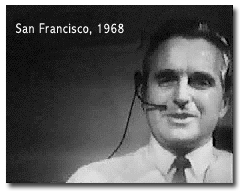 "DOUG Engelbart sat under a twenty-two-foot-high video screen, "dealing lightning with both hands." At least that's the way it seemed to Chuck Thacker, a young Xerox PARC computer designer who was later shown a video of the demonstration that changed the course of the computer world." from What the Dormouse Said, John Markoff.
"DOUG Engelbart sat under a twenty-two-foot-high video screen, "dealing lightning with both hands." At least that's the way it seemed to Chuck Thacker, a young Xerox PARC computer designer who was later shown a video of the demonstration that changed the course of the computer world." from What the Dormouse Said, John Markoff.
re: Explaining Twitter - One of Three Places for People
Update Dec 17, 2009: Facebook's controversial ex-post facto revision of member privacy settings along with the revenue driven rise of apps like Farmville (as well as sleezy internal promotion) lead me to revisit this, see Blog1232: Facebook: A Carnival Midway not a Neighborhood?
Facebook: A Carnival Midway not a Neighborhood?
 Oliver Marks wrote a very good post: Facebook: The Legal Rumblings Start Dec 17, 2009, on the Facebook's potential legal exposure due to its controversial changes to member privacy capabilities and settings. My comment: Oliver -- Very good followup on Facebook's awkward (to put it mildly) changes to selective privacy capabilities which were a large part of their differentiation vs Friendster and MySpace.
Oliver Marks wrote a very good post: Facebook: The Legal Rumblings Start Dec 17, 2009, on the Facebook's potential legal exposure due to its controversial changes to member privacy capabilities and settings. My comment: Oliver -- Very good followup on Facebook's awkward (to put it mildly) changes to selective privacy capabilities which were a large part of their differentiation vs Friendster and MySpace.
With over 70 million folk apparently hooked on "social" games like Farmville, targeted ads that seem to belong on late night TV, and incredibly lame attempts to nag folk get their friends to use Facebook more (giving "viral" a new and flu like meaning), I see Facebook becoming a downscale carnival midway more than a neighborhood. They certainly have a right to do that.
Originally I thought the equally lame and manipulative privacy changes would just contribute to the downmarket feel of the place.
But as you point out - EU privacy laws may land them in legal entanglements too.
Facebook is becoming a bad example rather than a good example for use of social software in the enterprise - or anywhere for that matter. Look out below!
How big a deal is Enterprise 2.0? What do you mean by "Big"?

I'm flattered that Professor Andrew McAfee cites Enterprise 2.0 Schism in his Nov 20, 2009 blog post Enterprise 2.0 is Not THAT Big a Deal, kicking off a neat discussion on serious points behind my tongue in cheek analysis. McAfee agrees that Enterprise 2.0 is a big deal - but "... I don't see E2.0's tools, approaches, and philosophies making obsolete managers, hierarchies, org charts and formal cross functional business processes". There's no need to use a 2.0 version for the Enterprise, but:
Peter Drucker and Enterprise 2.0 | Drucker Centenary
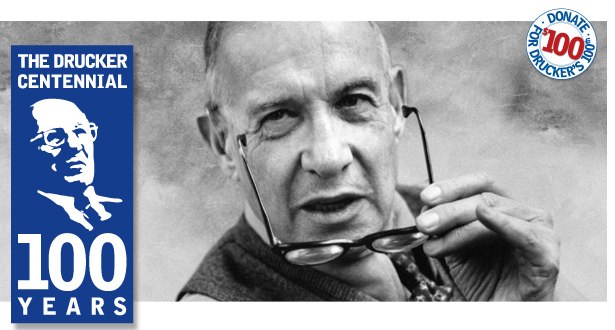 Earlier this week Oliver Marks wrote an excellent post on his Collaboration 2.0 Blog: The Purpose of a Business is to Create a Customer' - Peter Drucker Centenary. Oliver celebrates the Nov 19, 2009 Centenary of Peter Drucker's birth with two of his favorite Drucker bumper sticker quotes: " ‘Knowledge has to be improved, challenged, and increased constantly, or it vanishes‘ and ‘There is an enormous number of managers who have retired on the job‘, which somehow seem to fit together very well." then uses these quotes as context to discuss the disturbing findings of the 2009 Shift Index report and followup analysis by John Hagel, John Seely Brown and Lang Davidson of the Deloitte Center for The Edge. Please read Oliver's full post - you'll like it. Oliver was also used kind words to build on my earlier Enterprise 2.0 Schism post. Here's a slightly extended version of the comment I posted in reply, along with my two favorite Drucker bumper sticker quotes and several links to celebrate Drucker's birth and life.
Earlier this week Oliver Marks wrote an excellent post on his Collaboration 2.0 Blog: The Purpose of a Business is to Create a Customer' - Peter Drucker Centenary. Oliver celebrates the Nov 19, 2009 Centenary of Peter Drucker's birth with two of his favorite Drucker bumper sticker quotes: " ‘Knowledge has to be improved, challenged, and increased constantly, or it vanishes‘ and ‘There is an enormous number of managers who have retired on the job‘, which somehow seem to fit together very well." then uses these quotes as context to discuss the disturbing findings of the 2009 Shift Index report and followup analysis by John Hagel, John Seely Brown and Lang Davidson of the Deloitte Center for The Edge. Please read Oliver's full post - you'll like it. Oliver was also used kind words to build on my earlier Enterprise 2.0 Schism post. Here's a slightly extended version of the comment I posted in reply, along with my two favorite Drucker bumper sticker quotes and several links to celebrate Drucker's birth and life.
Enterprise 2.0 Schism
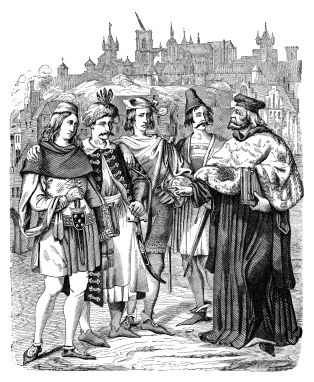 I have to confess that I've enjoyed watching recent rounds of Enterprise 2.0 discussion and mud wrestling. The fact that so many people enjoy debating definitions, values, doctrinal principals - even the existence of Enterprise 2.0 - makes me think that E2.0 might best be framed as a religious debate. With that in mind, I'd like to introduce a new and exciting element: schism.
I have to confess that I've enjoyed watching recent rounds of Enterprise 2.0 discussion and mud wrestling. The fact that so many people enjoy debating definitions, values, doctrinal principals - even the existence of Enterprise 2.0 - makes me think that E2.0 might best be framed as a religious debate. With that in mind, I'd like to introduce a new and exciting element: schism.
Introducing Proteus (demo)
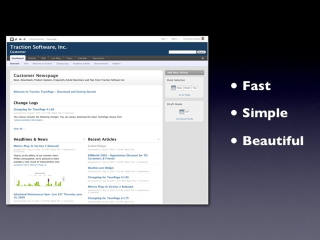
Traction Software Director of User Experience Michael Angeles introduces Traction's new Google Web Toolkit (GWT) based Proteus user interface with a brief tour (video below).
TUG 2009 Providence | Thank you!
 I'd like to thank all of the Traction customers, partners and friends who traveled to Providence last month to make TUG 2009 Providence as enjoyable as it was enlightening. Special thanks to keynote speakers Carmen Medina, Chris Nuzum, Stewart Mader and all of the customers and partners who participated in the Oct 14 Main event. And my personal thanks to everyone on the Traction Software team who worked so hard to bring TeamPage R4.2, the Oracle RDB backend, Attivo Advance Search, and the Proteus Google Web Tookit (GWT) UI to life. I don't know what we'll do to top TUG 2009 next year - but TUG members provides some excellent ideas! See TUG 2009 Providence | Keynotes by Carmen Medina, Chris Nuzum and Stewart Mader for links to TUG videos, slide shows, interviews, tech talks and more, along with how become a TUG member and join the conversation. TUG registration is free and open to the public.
I'd like to thank all of the Traction customers, partners and friends who traveled to Providence last month to make TUG 2009 Providence as enjoyable as it was enlightening. Special thanks to keynote speakers Carmen Medina, Chris Nuzum, Stewart Mader and all of the customers and partners who participated in the Oct 14 Main event. And my personal thanks to everyone on the Traction Software team who worked so hard to bring TeamPage R4.2, the Oracle RDB backend, Attivo Advance Search, and the Proteus Google Web Tookit (GWT) UI to life. I don't know what we'll do to top TUG 2009 next year - but TUG members provides some excellent ideas! See TUG 2009 Providence | Keynotes by Carmen Medina, Chris Nuzum and Stewart Mader for links to TUG videos, slide shows, interviews, tech talks and more, along with how become a TUG member and join the conversation. TUG registration is free and open to the public.
Where's Greg?
 You may have noticed a slow down in blog posts by Jordan and myself, and attributed that to our work for TUG 2009 Providence last week, and you'd be partially right (but it was fun - as you'll learn). You can also blame our slower blog posting to time spent on Twitter, both as individuals: @roundtrip (Greg Lloyd) and @jordanfrank and using the Traction Software corporate feed @tractionteam (which broadcasts the title and a shortened link to new content posted on TractionSoftware.com as well as original tweets).
You may have noticed a slow down in blog posts by Jordan and myself, and attributed that to our work for TUG 2009 Providence last week, and you'd be partially right (but it was fun - as you'll learn). You can also blame our slower blog posting to time spent on Twitter, both as individuals: @roundtrip (Greg Lloyd) and @jordanfrank and using the Traction Software corporate feed @tractionteam (which broadcasts the title and a shortened link to new content posted on TractionSoftware.com as well as original tweets).
2.0 Adoption Council | Neat Tweet!
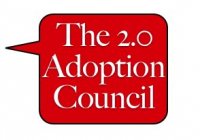
Susan Scrupski (aka @ITSinsider) tweets Sep 22, 2009: reading a great preso by a Council member. great testimony for e20 vendor Traction Software @TractionTeam
As We May Work - Andy van Dam
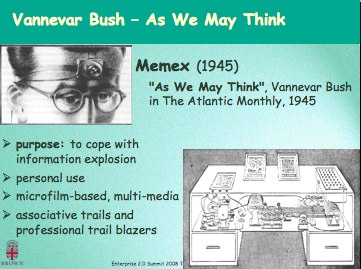
On April 17, 2008 Professor Andy van Dam of Brown University delivered the keynote address of the Enterprise 2.0 Summit 2009 Tokyo. Andy's title is a play on Vannevar Bush's July 1945 essay As We May Think. As We May Think inspired creation of pioneering hypertext systems by Andy, Ted Nelson, Doug Engelbart and others, leading to Tim Berners-Lee and the World Wide Web. The creators of these hypertext systems originally envisioned an environment where individuals could write, link, comment on and share what they wrote as well as search and read what others had written - core capabilities of what we now call social software for the public Web or an Enterprise. Andy's keynote is a personal history, and a vision of how the Web provides a new context for work as well as public communication, socialization, commerce, scholarship and entertainment. For the full slide set see As We May Work (.ppt 8.8MB), posted here with Andy's permission.
Is Twitter Like Going Out for a Smoke? - And Other stories
Bill Ives posted an interesting post Is Twitter Like Going Out for a Smoke?, responding to a Twitter / Water Cooler analogy by Arie Goldshlager and a smoker's network analogy pointed out by Stewart Mader and Gil Yehuda in Lessons from New York Smokers. I commented: Bill -- An interesting post and topic! I think there's likely an interesting history (and sociological studies) of how informal groups form and cross-link in businesses and other organizations.
Compliance and Enterprise 2.0 - For the right reasons
 Burton Group analyst Mike Gotta writes Compliance Doesn't Sell E2.0 … But It Should in his personal Collaborative Thinking blog. Mike summarizes a June 2009 E2.0 conference interview with Alexander Howard, quoted in Compliance concerns dog Enterprise 2.0 collaboration platforms. Howard asks:
Burton Group analyst Mike Gotta writes Compliance Doesn't Sell E2.0 … But It Should in his personal Collaborative Thinking blog. Mike summarizes a June 2009 E2.0 conference interview with Alexander Howard, quoted in Compliance concerns dog Enterprise 2.0 collaboration platforms. Howard asks:
Having versus Using Enterprise 2.0 Software

Gil Yehuda wrote a very good post today Enterprise 2.0 Thoughts to end the week. He talks about Enterprise 2.0 maturity, second wave adoption, focus on work, and levels of the conversation. It's a great post you should read in full and reflect on. One particular point caught my attention; Gil says: "... having a wiki, forum, blogs, etc. on the intranet and using a wiki, forum, blog effectively to improve the transparency and productivity of collaboration are very different indicators of progress."
Andy Keller talks about Traction's use of GWT | Video
May 12, 2009 5:38pm rotkapchen Great explanation: Traction Director of Engineering Andy Keller tells why Traction's chose GWT (Google Web Toolkit) for TeamPage's new interaction layer. View video inline below or youtube.com/watch…
Can't stuff the Web back in a box ...

On April 16 2009 Oliver Marks wrote The CIA's Collaboration Growth Curve & IBM's Lotusphere ecosystem connecting three topics: 1) the transformation of the CIA's collaborative practices; 2) how this relates to the concept of the collaboration curve introduced by John Hagel III, John Seely Brown (JSB), and Lang Davison, and 3) his reaction to IBM's Lotusphere Comes to You roadshow event in San Francisco that day. It's a great post which motivated me to add a comment which I expanded a bit below.
re: Explaining Twitter - One of Three Places for People
Rafe WTF of the day: @Josh comes back from lunch... "I got some cat food, do you want it?" Twitter.com 4:13PM 15 Apr 2009 ... much funnier than my example, but QED.
re: Explaining Twitter - One of Three Places for People
Update: Steve Buttry Information Content Conductor of Gazette Communications posted an excellent tip sheet: Leading your staff into the Twitterverse for a workshop he'll be leading for the American Society of Newpaper Editors. It's an great introduction to Twitter which covers linking, following, tools and ethics. I believe Steve's advice is just as valuable for neighborhood (Facebook) and workplace (Enterprise 2.0) microblogging. Steve writes:
Ada Lovelace Day | Professor Lee S. Sproull, Stern School, NYU

For this first Ada Lovelace Day I've chosen to write about Professor Lee Sproull an internationally-recognized sociologist whose research centers on the implications of computer-based communication technologies for managers, organizations, communities, and society. Professor Sproull is a pioneer and visionary in the rigorous study of what we now call social software.
Explaining Twitter - One of Three Places for People

Last week a friend who just signed up on Twitter said: "... just like Jon Stewart, I can't figure out how it works or why anyone would want to tweet or get anyone else's twitter. I had no idea what grunt and stalker is but I am assuming that is reality too. I put this all in the pocket with second life (stupid bulky awkward and totally useless)." So I reluctantly joined the crowd attempting to explain why people who have a job and have a life might be interested in Twitter. I decided to describe Twitter as one of three distinct places on the Web where I socialize every day: the public commons. The others two are my neighborhood and my workplace.
re: Kuka Systems TeamPage Case Study
 A customer story about giant orange robots - for real! How good can it get?
A customer story about giant orange robots - for real! How good can it get?
KUKA Titan Largest and strongest 6-axis industrial robot in the world. Payload capacity: 1000 kilograms
Kuka Systems TeamPage Case Study

See Kuka Systems for an excellent TeamPage story Jordan wrote in cooperation with this Traction TeamPage customer. KUKA is one of the world's leading suppliers of robotics as well as plant and systems engineering and has been in the automation technologies business since 1898. They build robotics systems for factory automation and are a leading worldwide supplier of assembly and welding systems, and other related machinery, servicing the automobile, aerospace, and energy industries.
re: Reinventing the Web
For an excellent first hand history of the Web - and a linked data proposal which seems to share many of the simple, scalable properties of his original invention - see Tim Berners-Lee's Feb 2009 TED Talk on the 20th anniversary of the Web:
 I18N ERROR: @tsiskin#footer_RSS_Feed
I18N ERROR: @tsiskin#footer_RSS_Feed